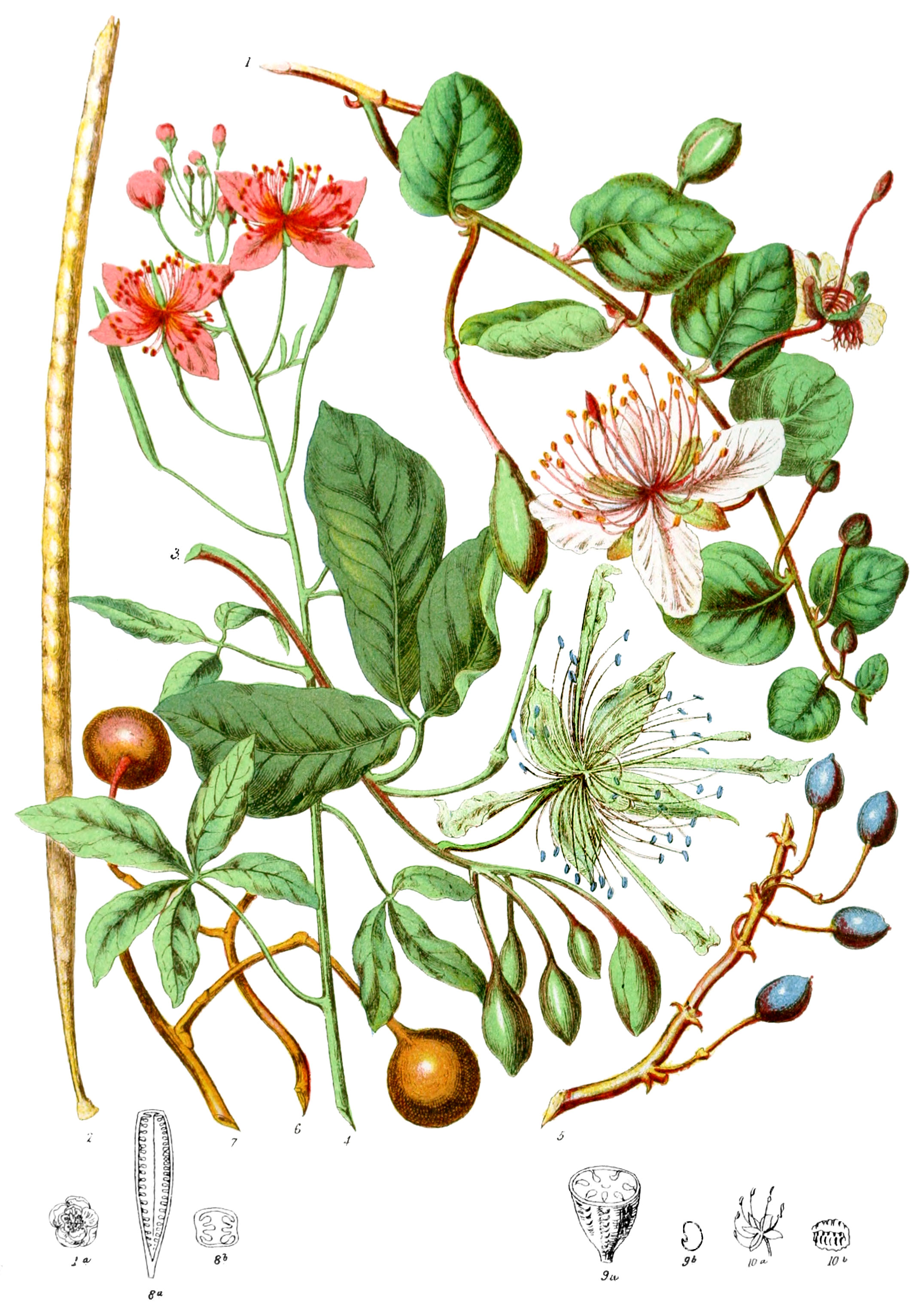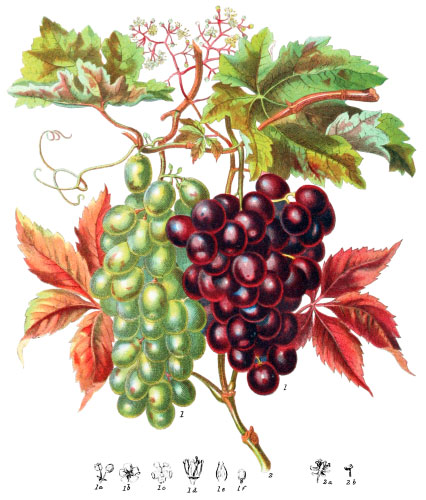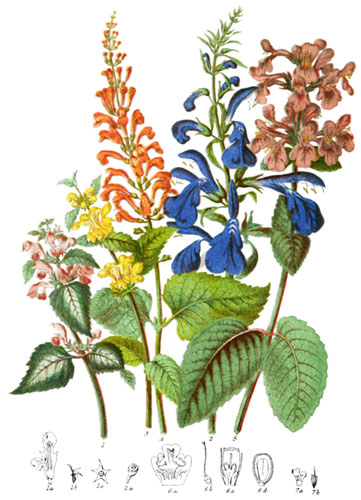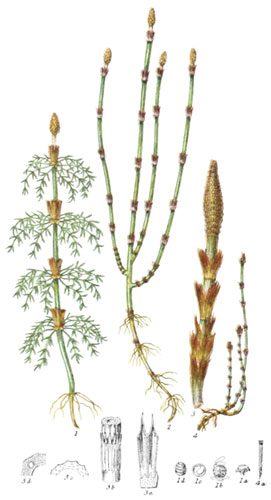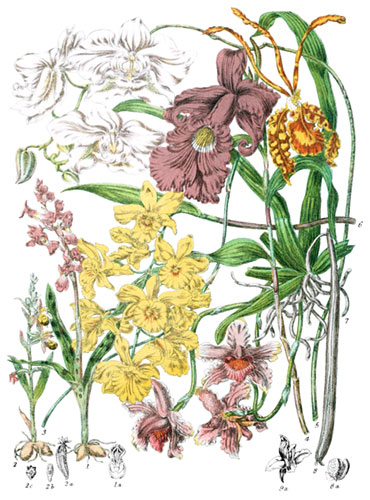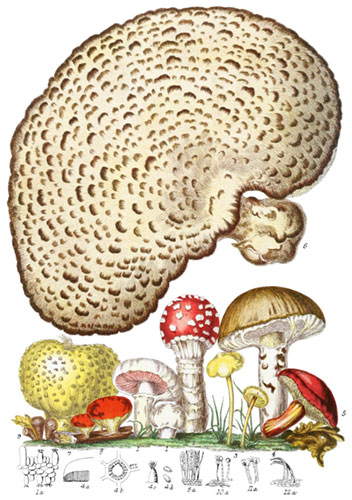Key characteristics
Trees, shrubs, and herbaceous plants; the leaves are alternate, stalked, undivided or palmate, without stipules at the base of the leaf-stalks, but sometimes having spines in their place. The flowers are solitary, or branching, or in a cluster at the ends of branches; the calyx has four sepals, either nearly distince or cohering in a tube of unequal size and shape; the petals are four or eight, folded over each other in the bud, occasionally unequal or wanting. The stamens are usually numerous, seldom only six, four of which are larger than the other two; in Physostemon (10a), two stamens have a singular appendage immediately below the anther. The disk on which the stamens are placed is at the top of the prolonged stalk of the ovary; it is sometimes developed into a fleshy round or stalk-like body, or into a plate of various form, bearing honey glands, with anthers on one side of it. The ovary is one-celled, with two or more ribs on the edge, to which the ovules are attached. The styles is long and slender, or wanting; the stigma generally round. The fruit is either a pod, gaping when ripe, or a berry with one cell. The seeds are generally many, very rarely only one, kidney-shaped, without albumen.
These plants have considerable resemblance to the Cruciform tribe, but are distinguished by the usually numerous stamens, and the kidney-shaped seeds.
Stimulant, pungent properties exist in the flowers and fruit.
The Arabic denomination of the chief plant of this Tribe is Kabar, from which the Greek, Latin, and modern European names have all been derived.
Select plants in this order
Not all plants listed are illustrated and not all plants illustrated are listed.
- The various species of Capparis are low shrubs, differing in appearance, some bearing delicate flowers, and of considerable beauty; but the general character is thorny, rough, and wild; some, which inhabit the deserts, have a remarkably dreary aspect, none more so than the Capparis aphylla; the oblong leaves soon wither and fall off, leaving only the slender stiff branches, with small clusters of flowers and strong spines.
- C. horrida is nearly similar, beset with hooked spines, in pairs, at the base of the flower-stalks.
- C. spinosa (1) is the most useful species owing to its agreeably pungent qualities; it is very commonly found growing, after the manner of the Bramble, in rocky, stony places, or amongst ruins, in Southern Europe. It is also cultivated in the South of France, and in Sicily, for the sake of the flower-buds, in which the peculiar pungent properties are already fully developed; they are gathered whilst young, and preserved as a stimulating condiment to insipid boiled meats. The chief supply comes from Sicily, and the isles and coasts of the Mediterranean; the unripe fruit has similar properties, and is also prepared as a pickle. Those buds which are suffered to remain on the plant continue to expand singly, in a continued series, and are beautiful, although very short-lived.
- C. Æghyptiaca affords a refreshing and wholesome addition to the food of the Egyptians.
- C. rupestris to the Greeks.
- C. sepiaria has an umbel of small flowers at the ends of the branches, and a pair of hooked spines at the base of each leaf-stalk. Its nature makes a good hedge-shrub in India, where it is thus used around Shikarpoor and elsewhere.
- The pods of C. Breynia (2) are twelve inches in length.
- Cratœva was named in honour of Cratœvus, a Greek botanist who lived in the time of Hippocrates.
- C. fragrans (3) was brought from Sierra Leone at the close of the last century, having been discovered there by Afzelius, a professor of botany in the University of Upsal; he found it spreading over the rocks, near rivers, amongst the mountains, in the same kind of localities as in the island of Bananas, where he had previously seen the plant. The flowers are unlike others of this tribe, of short duration, but come forth in succession during several weeks, and are highly fragrant.
- C. gynandra has been called the Garlic Pear; the bark of the root has powerful blistering properties.
- The berries of C. Nurvala are said to be juicy, and of pleasant flavour.
- C. Tapia, of the East Indies, bears a fruit as large as an orange, filled with a mealy kind of pulp, having the smell of garlic; the bruised leaves are employed to alleviate inflammation; the bark is bitter and tonic.
- The natives of Tahiti consider C. religiosa as peculiarly suited to burial grounds, and plant it on the graves.
- Polanisia (4) is one of these plants, having a slender seed-vessel, like the Cruciferous tribe in form, although the seeds are attached differently. Cleome shows still more affinity with that tribe, the flowers having six stamens, of which two are shorter. The seed-vessel usually remains upright, near the stem when ripe.
- C. violacea has a long drooping capsule; this species is frequent in vineyards in Portugal.
- Colicodendron is said by Martius to be injurious to cattle; and the species of Capparis called Fruta de Burro bears an extremely poisonous fruit.
Locations
This tribe abounds in the Tropics and adjacent countries; in Africa the species are numerous. Capparis extends to the south of Europe. Cleome is found in Portugal Polanisia as far north as Canada; a few species grow in the northern provinces of the United States.
Legend
- Capparis spinosa, Common Caper-tree. Sout Europe.
- Flower-bud, opened.
- Capparis Breynia, Oleaster-leaved Caper-tree. West Indies.
- Cratœva fragans, Sweet-scented Garlic-pear. Sierra Leone.
- Polanisia chelidonii, Celadine-flowered Polanisia. East Indies.
- Sodada decidua. Egypt.
- Capparis ovata, Fruit.
- Cratoœva Roxburghii, Fruit.
-
- Seed-vessel of Capparis Sinclairii.
- Cross-section.
-
- Section of Fruit of C. Ægyptiaca.
- Seed.
-
- Flower of Physostemon.
- Seed, magnified.
Explore more
Posters
Decorate your walls with colorful detailed posters based on Elizabeth Twining’s beautiful two-volume set from 1868.
Puzzles
Challenge yourself or someone else to assemble a puzzle of all 160 botanical illustrations.
